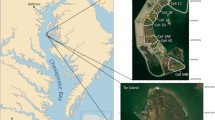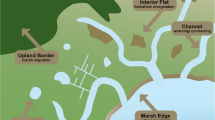Abstract
Inter-tidal marshes are dynamic diverse ecosystems at the transition zone between terrestrial and ocean environments. Geomorphologically, inter-tidal salt marshes are vegetated landforms at elevations slightly greater than mean tidal levels that have distributed channels formed under ebb (drainage) tidal flows that widen and deepen in the seaward direction. The drainage channels enable tidal flows to circulate sediments and nutrients through the marsh system during normal tidal events, while depositing sediments during storm or seismic events. This dynamic system encourages considerable biodiversity while simultaneously providing water quality enhancement features that service marsh terrestrial life and marine life in the estuary. Reservoir creation limiting sediment transport, anticipated large increases in sea levels as well as agricultural and urban development have resulted in significant loss of inter-tidal marshes and subsequent adverse impacts on waterfowl, infauna and fisheries. The complex and continuously changing marsh channel hydraulics and sedimentary processes have severely constrained quantitative modeling of these marsh systems such that restoration/creation efforts remain something of an empirical science and further assessments are needed.The purpose of this paper is to outline current understanding of salt marsh hydrodynamics, sediment accretion processes and subsequent response of marsh vegetation to set the stage for assessment of a marsh restoration effort along San Pablo Bay near San Francisco, California. Several kilometers of drainage channels were constructed in a 624 ha disturbed salt marsh to restore tidal circulation and vegetation so as to enhance habitat for threatened species (e.g. clapper rail, harvest mouse, delta smelt and potentially anadromous fish species). Two distinct drainage channel systems (`east' and `west') were installed having similar channel dimensions common to salt marshes in the region, but having design bankfull tidal prism volumes differing by a factor of two. Following channel excavation, main channel tidal flows and sediment loads as well as marsh sediment accretion rates were monitored to assess the relative success of the excavation in restoring tidal circulation and vegetation (Salicornia spp.) to the marsh. Annual aerial surveys corroborated with ground-truthing indicated that marsh vegetation rapidly expanded, from 40 to 85% coverage several years following excavation. The `east' channel intake was nearly completely silted in within three years. However, channel surveys and flow measurements indicated that the `east' channel system tidal prism was only about 1200 m3, more than an order of magnitude less than that of the stable `west' channel system. Marsh sediment accretion rates were on the order of 7–8 mm yr-1, a rate common to the Pacific coast region that exceeds estimated sea level rise ratesof ∼2 mm yr-1. East channel network siltation resulted in storm and spring tidal flood ponding such that marsh vegetation coverage decreased to 51% of the marsh area and related habitat expansion decreased. These results are considered in terms of the primary inter-tidal marsh factors affecting possible restoration/creation strategies.
Similar content being viewed by others
References
Allen, J. R. L.: 1997, ‘Simulation models of salt-marsh morphodynamics: Some implications for high-intertidal sediment couplets related to sea-level change’, Sediment. Geol. 113, 211–223.
Allen, J. R. L., Cunningham, M., Greenwood, A. and Rosenthal, L.: 1992, The Value of California Wetlands; An Analysis of their Economic Benefits, Produced for and published by: The Campaign to Save California Wetlands, Oakland, CA.
Atwater, B. F., Conrad, S. G., Dowden, J. N., Hedel, C.W., MacDonald, R. L. and Savage, W.: 1979, ‘History, Landforms and Vegetation of the Estuary’s Tidal Marshes’, in T. J. Conomos (ed.), San Francisco Bay: The Urbanized Estuary, Proceedings 58th Annual Meeting of Pacific Division AAAS, 12–16 June 1977, San Francisco, CA, U.S.A.
Bayliss-Smith, T. P., Healey, R., Lailey, R., Spencer, T. and Stoddart, D. R.: 1979, ‘Tidal flows in salt marsh creeks’, Estuarine Coast. Marine Sci. 9, 235–255.
Boon III, John D.: 1978, ‘Suspended-solids Transport in a Salt Marsh Creek–An Analysis of Errors’, in B. J. Kjerfve (ed.), Estuarine Transport Processes, University of South Carolina Press, Columbia, SC, U.S.A., pp. 157–160.
Boon III, J. D.: 1975, ‘Tidal discharge asymmetry in a salt marsh drainage system’, Limnol. Oceanogr. 20(1), 71–80.
Childers, D. L. and Day Jr., J.W.: 1990, ‘Marsh-water column interactions in two Louisiana estuaries. I. Sediment dynamics’, Estuaries 13(4), 393–403.
Chmura, G. L., Coffey, A. and Crago, R.: 2001, ‘Variation in surface sediment deposition on salt marshes in the Bay of Fundy’, J. Coast. Res. 17(1), 221–227.
Coats, R., Williams, P. B., Cuffe, C. K., Zedler, J. B., Reed, D., Watry, S. M. and Noller, J. S.: 1995, ‘Design Guidelines for Tidal Channels in Coastal Wetlands’, Reportprepared for the U.S. Army Corps of Engineers, Waterways Experiment Station.
Dettinger, M., Smith, R., Cayan, D. Peterson, D. and Uncles, R.: 1995, Hydroclimatology of San Francisco Bay Freshwater Inflows and Salinity, USGS, http://water.wr.usgs.gov/forecast/hydroclim/.
Faber, P.: 1991, ‘The Muzzi Marsh, Corte Madera, California. Long-term observations of a restored marsh in San Francsico Bay in Coastal Wetlands’, in Symposium on Coastal and Ocean Management, ASCE, New York, NY, U.S.A.
French, J. R. and Stoddart, D. R.: 1992, ‘Hydrodynamics of salt marsh creek systems: Implications for marsh morphological development and material exchange’, Earth Surface Process. Landforms 17, 235–252.
French, J. R. and Clifford, N. J.: 2000, ‘Hydrodynamic modeling as a basis for explaining estuarine environmental dynamics: Some computational and methodological issues’, J. Hydrol. Process. 14, 2089–2108.
Gilbertson, D. D., Kent, M. and Pyatt, F. B.: 1985, Practical Ecology, Hutchinson & Co., Ltd., London, U.K.
Goodwin, P.: 1994, ‘Physical Processes in Tidal Wetlands Restoration’, in R. A. Falconer and P. Goodwin (eds), Wetland Management. Proceedings of the International Conference Organized by the Institution of Civil Engineers, Thomas Telford, London, U.K., pp. 130–142.
Grismer, M. E.: 1999, ‘Wetland hydrology and water quality assessment’, Lowland Technol. Inter. 1(1), 19–33.
Grismer, M. E.: 2000, ‘Drainage channel design and restoration of inter-tidal marshes’, Lowland Technol. Inter. 2(2), 13–27.
Haltiner, J., Zedler, J. B., Boyer, K. E., Williams, G. D. and Callaway, J. C.: 1997, ‘Influence of physical processes on the design, functioning and evolution of restored tidal wetlands in California (U.S.A.)’, Wetlands Ecol. Manage. 4(2), 73–91.
Hughes, C. E., Binning, P. and Willgoose, G. R.: 1998, ‘Characterisation of the hydrology of an estuarine wetland’, J. Hydrol. 211, 34–49.
Jaffe, B., Smith, R. and Torresan, L. Z.: 1996, Sedimentation Changes in San Pablo Bay, http://sfbay.wr.usgs.gov/access/Bruce/intro.html/. Poster presented at 3rd Biennial State of the Estuary Conference, 10–12 October 1996, in San Francisco, CA, U.S.A.
Josselyn, M.: 1983, The Ecology of San Francisco Bay Tidal Marshes: A Community Profile, U.S. Fish and Wildlife Service, Office of Biological Services, Washington, D.C., U.S.A., FWS/OBS-83/23.
Josselyn, M., Zedler, J. and Griswold, T.: 1990, ‘Wetland Mitigation along the Pacific Coast of the United States’, in J. A. Kusler and M. E. Kentula (eds), Wetland Creation and Restoration: The Status of the Science, Environmental Research Laboratory, Corvallis, OR, U.S.A., EPA 600/3-89/038b, pp. 3–36.
Kamman, R. Z.: 1998, ‘Hydrodynamic Models and Adaptive Management in Tidal Wetland Restoration’, in Presentation Summaries, ASCE Wetlands Engineering & Restoration Conference, Denver, CO, U.S.A., p. 19.
Karr, J. R.: 1993, ‘Measuring Biological Integrity: Lessons from Streams’, in S. Woodley, J. Kay and G. Francis (eds), Ecological Integrity and the Management of Ecosystems, St. Lucie Press, Delray Beach, FL, U.S.A., pp. 83–104.
Leonard, L. A.: 1997, ‘Controls of sediment transport and deposition in an incised mainland marsh basin, southeastern North Carolina’, Wetlands 17(2), 263–274.
Leopold, L. B., Collins, J. N. and Collins, L. M.: 1993, ‘Hydrology of some tidal channels in estuarine marshland near San Francisco’, Catena 20, 469–493.
Mahal, B. E. and Park, R. B.: 1976, ‘The ecotone between Spartina foliosa Trin. and Salicornia virginica L. in salt marshes of northern San Francisco Bay. II. Soil aeration and tidal immersion’, J. Ecol. 64, 811–819.
Merrill, R. and Siegel, S.: 1986, Investigation of a salt marsh tidal prism. Unpublished manuscript. Written for LA 222, Prof. Leopold. University of California, Berkeley, CA.
Mitsch, W. J. and Gosselink, J. G.: 1993, Wetlands, 2nd ed., Van Nostrand Reinhold, New York, NY, U.S.A.
Nordstrom, K. R.: 1992, Estuarine Beaches, Elsevier Science Publishing, Inc., New York, NY, U.S.A.
Nordstrom, K. F. and Roman, C. T.: 1996, Estuarine Shores: Evolution, Environments and Human Alterations, John Wiley & Sons, New York, NY, U.S.A.
Pethick, J. S.: 1994, ‘Estuaries and Wetlands: Function and Form’, in R. A. Falconer and P. Goodwin (eds), Wetland Management. Proceedings of the International Conference Organized by the Institution of Civil Engineers, Thomas Telford, London, U.K., pp. 75–87.
Pethick, J. S.: 1980, ‘Velocity surges and asymmetry in tidal channels’, Estuarine Coast. Marine Sci. 11, 331–345.
Reed, D.: 1988, ‘Sediment dynamics and deposition in a retreating coastal saltmarsh’, Estuarine Coast. Shelf Sci. 26, 67–79.
Rhoads, P. et al.: 1996, Habitat Restoration in Aquatic Ecosystems: A Review of the Scientific Literature Related to the Principles and Practice of Habitat Restoration. Prepared in support of the CalFed effort.
Sanderson, E. W., Ustin, S. L. and Foin, T. C.: 2000, ‘The influence of tidal channels on the distribution of salt marsh species in Petaluma Marsh’, CA, U.S.A., Plant Ecol. 146, 29–41.
Sivakumaran, K.: 1998, ‘Designing Channels in Tidal Wetlands–Revisited’, in Presentation Summaries, ASCEWetlands Engineering & Restoration Conference, Denver, CO, U.S.A., p. 18.
Talley, T. S. and Levin, L. A.: 1999, ‘Macrofaunal succession and community structure in Salicornia marshes of southern California’, Estuarine Coast. Shelf Sci. 49(5), 713–731.
Wang, F. C., Lu, T. and Sikora, W. B.: 1993, ‘Intertidal marsh suspended sediment transport processes’, J. Coast. Res. 9(1), 209–220.
Wang, F. C., Ransibrahmanakul, V., Tuen, K. L., Wang, M. L. and Zhang, F.: 1995, ‘Hydrodynamics of a tidal inlet in Fourleague Bay/Atchafalaya Bay, Louisiana’, J. Coast. Res. 11(3), 733–743.
Ward, L. G.: 1981, ‘Suspended-material transport in marsh tidal channels, Kiawah Island, South Carolina’, Marine Geol. 40, 139–154.
Warner, J. C., Schladow, S. G. and Schoelhamer, D. H.: 1999, ‘Summary and Analysis; Hydrodynamic and Water Quality Data for the Napa-Sonoma Marsh Complex’, Final Reportto USDI-Geological Survey, Sacramento, CA, U.S.A.
Winfield, T. W., Williams, P. and Florsheim, J.: 1995, Review of physical and biological performance of tidal marshes constructed on dredged materials in San Francisco Bay, CA. Society for Ecological Restoration, Coastal Systems Abstracts, Seattle, WA, U.S.A.
Zedler, J. B.: 1996, ‘Tidal Wetland Restoration: A Scientific Perspective and Southern California Focus’, Report No. T-038, California Sea Grant College System, University of California, La Jolla, CA, U.S.A.
Zeff, M. L.: 1999, ‘Salt marsh tidal channel morphometry: Applications for wetland creation and restoration’, Restor. Ecol. 7(2), 205–211.
Author information
Authors and Affiliations
Corresponding author
Rights and permissions
About this article
Cite this article
Grismer, M.E., Kollar, J. & Syder, J. Assessment of Hydraulic Restoration of San Pablo Marsh, California. Environ Monit Assess 98, 69–92 (2004). https://doi.org/10.1023/B:EMAS.0000038180.63065.36
Issue Date:
DOI: https://doi.org/10.1023/B:EMAS.0000038180.63065.36




